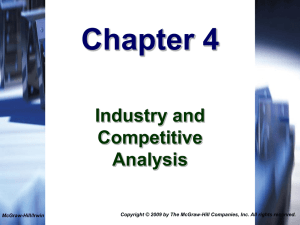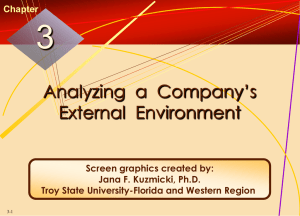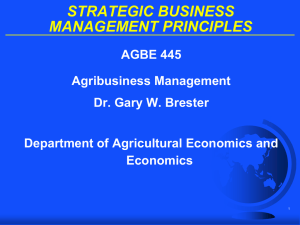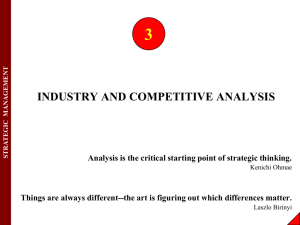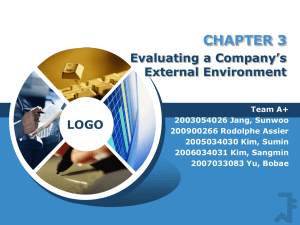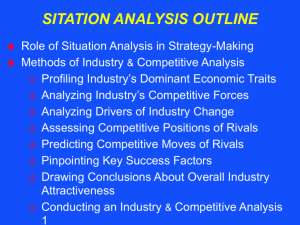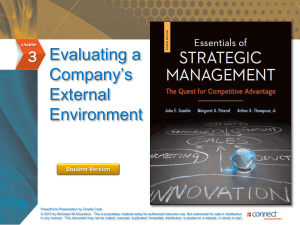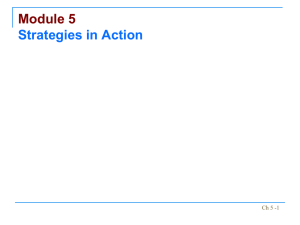External Analysis
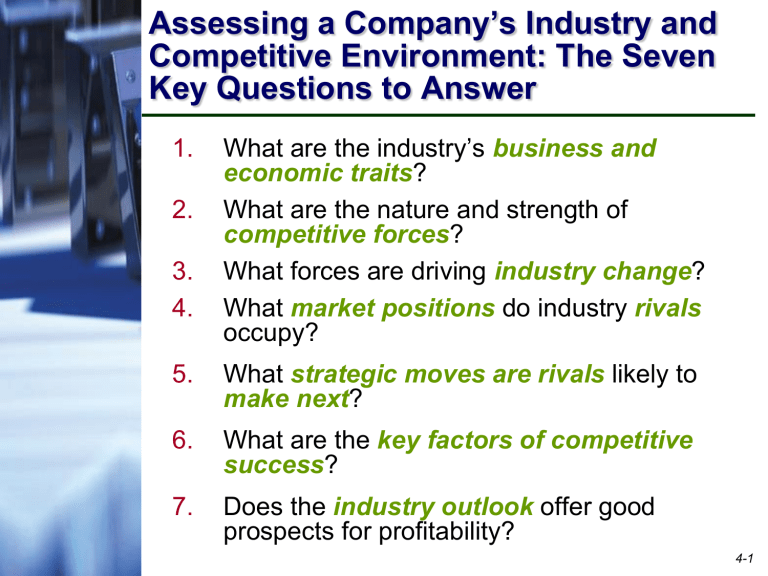
Assessing a Company’s Industry and
Competitive Environment: The Seven
Key Questions to Answer
1.
What are the industry’s business and economic traits ?
2.
What are the nature and strength of competitive forces ?
3.
What forces are driving industry change ?
4.
What market positions do industry rivals occupy?
5.
What strategic moves are rivals likely to make next ?
6.
What are the key factors of competitive success ?
7.
Does the industry outlook offer good prospects for profitability?
4-1
1. Identifying the Industry’s
Dominant Economic Features
Market size and growth rate
Number of rivals
Scope of competitive rivalry
Pace of technological change
Degree of vertical integration
Need for economies of scale
Learning and experience curve effects
4-2
2. Porter’s Five Forces Model of
Competition
4-3
When Is the Bargaining
Power of Buyers Stronger ?
Buyers are large and can demand concessions
Buyer switching costs for substitutes are low
The number of buyers is small
Buyer demand is weak or declining
Buyers are well-informed about sellers’ products, prices, and costs
Buyers threaten to integrate backward
4-4
When Is the Competition
From Substitutes Stronger ?
There are many good substitutes that are readily available
Substitutes are attractively priced
Substitutes have comparable or better quality and performance
End-users have low switching costs
4-5
When Is the Bargaining
Power of Suppliers Stronger ?
Industry members incur high switching costs
Needed inputs are in short supply
Supplier provides a differentiated input that enhances the quality or performance of sellers’ products
There are only a few suppliers of a specific input
Some suppliers threaten to integrate forward
4-6
When Is the Threat of Entry Stronger ?
Industry growth is rapid and profit potential is high
Incumbents are unwilling or unable to contest a newcomer’s entry efforts
The pool of entry candidates is large
Entry barriers are low
4-7
What Causes Rivalry to Be
Stronger ?
Competing sellers regularly launch fresh actions to boost market standing
Declining demand or slow market growth
The products or services offered by rivals are standardized or weakly differentiated
One or more industry rivals becomes dissatisfied with their market standing
4-8
What Causes Rivalry to Be
Stronger ?
Number of rivals increases
Buyer costs to switch brands are low
Industry conditions tempt rivals use price cuts or other competitive weapons to boost volume
Outsiders have recently acquired weak firms in the industry and are trying to turn them into major market contenders
4-9
When the Five Competitive Forces
Result in Attractive Market
Conditions
An industry’s competitive environment tends to be attractive from a profit-making standpoint when
Rivalry is moderate
Entry barriers are high and no firm is likely to enter
Good substitutes do not exist
Suppliers and customers are in a weak bargaining position thereby producing competitive pressures that are very weak!
4-10
When the Five Competitive Forces
Result in Unattractive Market
Conditions
An industry’s competitive environment tends to be unattractive from a profit-making standpoint when
Rivalry is strong
Entry barriers are low and new competitors are likely to enter
Good substitutes exist
Suppliers and customers are in a strong bargaining position thereby producing competitive pressures that are very intense or fierce!
4-11
3. Analyzing Driving Forces
1.
Identify forces likely to reshape industry competitive conditions
Changes likely to take place within next 1 – 3 years
Usually no more than 3 - 4 factors qualify as real drivers of change
4-12
Analyzing Driving Forces
2.
Assess impact of driving forces on industry attractiveness
Are the driving forces causing demand for product to increase or decrease ?
Are the driving forces acting to make competition more or less intense ?
Will the driving forces lead to higher or lower industry profitability?
3.
Determine what strategy changes are needed to prepare for impact of driving forces
4-13
External Environmental Factors
Shaping A Company’s Choice of
Strategy
4-14
Basic Driving Forces
Economic Conditions
Technological change
Demographics
Legislation and regulation
Social Values and Lifestyles
4-15
4. Identifying the Market Positions of
Rivals: Strategic Group Maps
4-16
What Can Be Learned from
Strategic Group Maps
Driving forces and competitive pressures often favor some strategic groups and hurt others
Competitive pressures may cause the profit potential of different strategic groups to vary
Identification of competitive
“white spaces” or
“blue ocean” opportunities
4-17
5. Predicting the Next Strategic
Moves Rivals Are Likely to Make
Profiling key rivals involves gathering competitive intelligence about
Thinking and leadership styles of top executives
Identifying trends in the timing of new product launches and marketing promotions
Considering which rivals have the motivation and capability to make major strategy changes
4-18
6. Pinpointing the Key Factors for Competitive Success
Key Success Factors (or KSFs ) are competitive factors most affecting every industry member’s ability to prosper.
KSFs include:
Specific product attributes
Necessary resources, competencies, and capabilities
Specific intangible assets
Competitive capabilities
4-19
Three Questions to Ask in
Identifying Industry Key Success
Factors
1.
On what basis do buyers choose between brands ?
2.
What resources are needed to compete successfully?
3.
What shortcomings are almost certain to put a company at a competitive disadvantage ?
4-20
Example: KSFs for the
Beer Industry
Full utilization of brewing capacity -to keep manufacturing costs low
Strong network of wholesale distributors -- to gain access to retail outlets
Clever advertising -- to induce beer drinkers to buy a particular brand
4-21
Example: KSFs for Apparel
Manufacturing Industry
Appealing designs and color combinations -- to create buyer appeal
Low-cost manufacturing efficiency -- to keep selling prices competitive
4-22
Example: KSFs for Tin and
Aluminum Can Industry
Locating plants close to end-use customers -- to keep costs of shipping empty cans low
Ability to market plant output within economical shipping distances
4-23
7. Deciding Whether the Industry
Presents an Attractive Opportunity
Involves assessing whether the industry and competitive environment is attractive or unattractive for earning good profits
Draws upon all the previous analysis
The industry’s growth potential
The intensity of competition
Whether the impacts of the driving forces are positive or negative
The company’s competitive position in the industry relative to rivals
How well the company performs the industry’s key success factors
4-24
